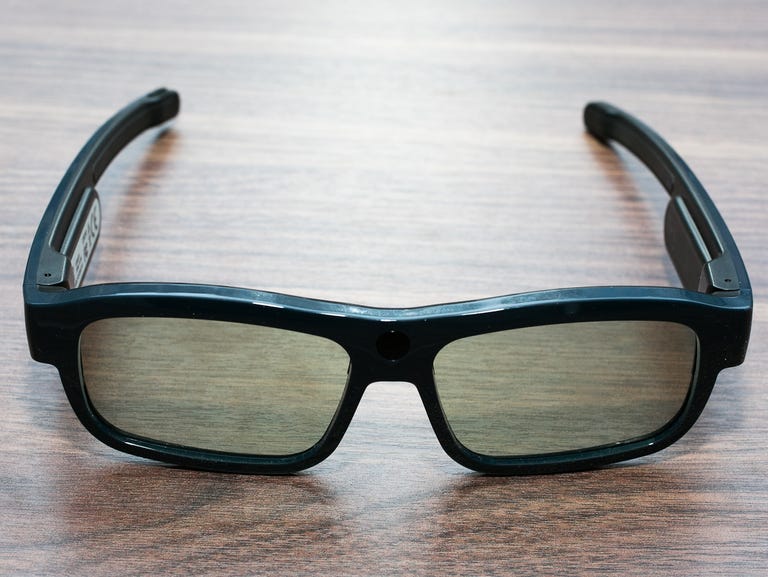 Why You Can Trust CNET
Why You Can Trust CNET Xpand X104 YOUniversal 3D glasses review: Xpand X104 YOUniversal 3D glasses
Xpand X104 YOUniversal 3D glasses
With passive 3D TV, the kind used in most U.S. movie theaters, just about any cheap polarized 3D glasses will work with any TV. With its rival active 3D, however, things are less simple and more expensive.
The Good
The Bad
The Bottom Line
XpanD, a manufacturer of active 3D glasses for movie theaters and, increasingly, 3D televisions, aims to make active 3D glasses simpler to use. Its YOUniversal specs are the company's latest designed to work with multiple brands of television, and the only 3D glasses said to work with almost every active 3D TV released in 2010, 2011 and this year. They're a bit more expensive than competitors, but better and more versatile in many ways.
Unlike previous models like the X103, the haplessly named YOUniversal glasses -- I'll just call them X104 from here on out to save us all some embarrassment -- can ulilize an optional Bluetooth/RF dongle ($20; widely available in about 4 weeks) to sync with 2012 and later TVs that adhere to the Full HD 3D standard, as well as with 2011 Samsung TVs. Dongle attached, they compete directly against other universal standard-compliant glasses like the Samsung SSG-4100GB and Panasonic TY-ER3D4MU.
The question for owners of 2012 Panasonic and 2011/2012 Samsung active 3D TVs -- the only current TVs also compliant with the standard -- then becomes "which ones should I buy?"
The short answer is, as always, "what do you want?" If you just want to get 3D capability as cheaply as possible, the Samsungs are a shoo-in. If you're willing to pay more for better comfort and durability, I'd recommend the Panasonics. The more expensive Xpand glasses appeal to a smaller niche than either: people who actually anticipate regularly watching active 3D on multiple TVs (namely, ones incompatible with those Samsung or Panasonic glasses) in addition to their primary 3D television.
That's because among the three sets of glasses, only the Xpand X104s are truly compatible with every active-3D TV. The others only work with sets that adhere to the new standard--yes, Panasonic's 2012 glasses are actually incompatible with Panasonic's own 2011 3D TVs, for example. Since the X104s recognize both infrared (IR) and optionally Bluetooth (RF) synch signals sent from active 3D TVs, they can do it all.
Xpand offers the X104 in five different size/color combinations; click "See all models" at the top of the page for all of the choices. I was sent the large, blue/black variety, which when worn over my regular glasses made me look even dorkier than usual. The thick frames and even thicker temples -- the "legs" that hook your ears to the frames -- exude a kind of Buddy Holly hipster cred, however, and feel more solid than the Panasonics and especially the flimsy Samsungs.
Between the three, the Panasonics were the most comfortable for me to wear, although their advantage over the Xpand specs diminished when I removed my prescription glasses. The Xpand glasses are heavier and tended to pinch the back of my head behind my ears more, especially when I wore my prescription glasses, and they perched further on the end of my nose. I also liked the blackout effect of the Panasonics' big wide temples for shutting out ambient light; the Xpand glasses were pretty good in this regard, and the Samsungs were, again, the worst of the three.
The X104s also have more extra features than the others, the most important being compatibility with numerous TVs and projectors. Here's the full list. I did not test compatibility with any TVs aside from the Panasonic TC-P50ST50 and Samsung PN60E8000 (see below), which both synced fine using the RF dongle.
The company also includes more accessories than do Panasonic and Samsung, namely a nice case, two different detachable nose bridge pieces, a cleaning cloth, and of course, a charging cable. Xpand estimates 35 hours per on a charge, five more than Panasonic. One end of the cable is standard USB, but the other is proprietary, and its matching connection on the glasses is where you'll stick the RF dongle.
Xpand also offers specialized PC software said to enable adjustment of the active shutter timings. I didn't test the software tweaks for this review, but here's a PDF explanation of how it works if you're curious.
The PC connection also allows for firmware upgrades. One recent update apparently added support for dual view -- where two 2D programs can be viewed simultaneously on the same 3D TV by two different viewers. I didn't test that feature.
I spent a couple hours watching my favorite 3D test film at the moment, "Hugo," in an attempt to discern differences in picture quality among the three glasses, switching glasses and views on the two TVs mentioned above. They looked close enough to one another to be indistinguishable in most scenes. Again, I ended up feeling that more closed view of the Panasonics improved perceived black-level performance, but the fat temples of the Xpand glasses helped a bit in this department as well.
Overall I liked the lighter, better-fitting Panasonic glasses best of the three, followed by the X104s, and then the Samsungs. The Xpand glasses make sense for people who need the flexibility to watch active 3D on more than one brand of 3D TV, or people who can save some money buying the X104s over the glasses they'd otherwise need to watch 3D.


